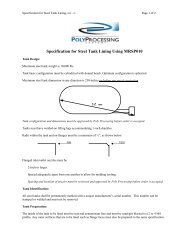Environmental Stress Crack Resistance - Poly Processing
Environmental Stress Crack Resistance - Poly Processing
Environmental Stress Crack Resistance - Poly Processing
You also want an ePaper? Increase the reach of your titles
YUMPU automatically turns print PDFs into web optimized ePapers that Google loves.
Increasing the short chain branching will increase the ESCR of polyethylene. Themore frequent these branches are, the less the level of Crystalinity in the material. Withlower crystallinity or density, comes higher ESCR, as we have already discussed.This increase in ESCR with density is only true up to a certain level because of theeffect of density (crystallinity) on molecular strength. If the strength drops too low, thenthe resistance of the material to spreading of the defect regions will also decrease.Hence, there is somewhat a complex relationship between molecular strength, densityand ESCR.c- Effects of Density and Crystallinity:As we have already noted, in general, the higher the level of crystallinity orproportion of crystalline to amorphous regions, the higher the density and the lower theESCR of the material. The explanation arises directly from our analysis of the effects ofthe interphase region. Even when the density of a polymer is very high, that does notmean that the density is associated with only a few very large crystalline regions. Infact, there continues to be a large number of crystalline regions because, even whenthe number of short chain branches is small, there are still other factors that limit thesize of the crystals. One factor is the presence of some short branch side chains, nomatter how high the density is.Another factor is the high rate of crystal initiation throughout the molecule. Thatmeans that as cooling occurs, crystals begin in many different areas throughout thepolymer melt. These crystals all grow until they meet another crystalline region. Hence,a highly crystalline material looks like a patchwork quilt with many different crystalregions up against each other.Each of these crystal regions is surrounded by an interphase region. The moleculesin these interphases are still highly stressed. Because of the nature of the crystalgrowth, there are probably more of these interphase regions in a high density materialthan in one in which large amorphous regions are present. Hence, the areas that aremost susceptible to starting stress cracks (the interphases) are even more prevalent inhigh density materials than in low density materials. This explains why high densitylinear polyethylene resin grades have lower ESCR values when compared to lowdensity polyethylene, see table 1 page 6 of this article.4- Measuring ESCR:There are a number of accelerated tests that are used to determine the polymer’sESCR. The most widely used, and accepted, test, especially in the rotomolding industry,is the Bent Strip method, ASTM D1693. The purpose of this test is to accelerate theconditions that lead to stress cracking so that the effects can be see in a shorter timeframe. Therefore, the rectangular test samples are severely bent, or stressed, and thenimmersed in a highly active surfactant material (Igepal) often under elevated6
















